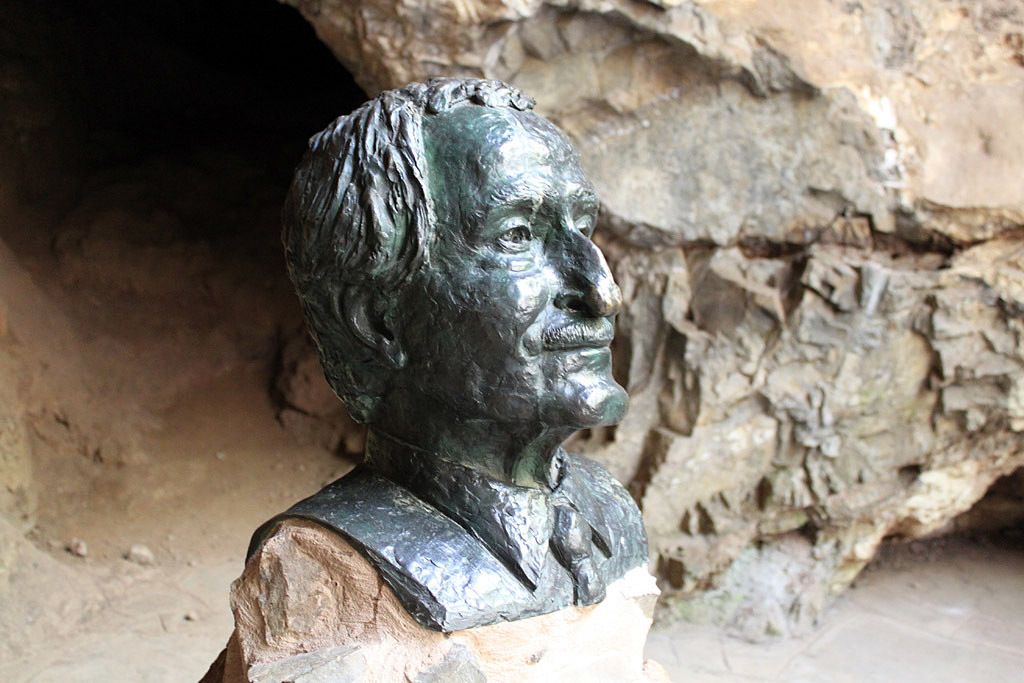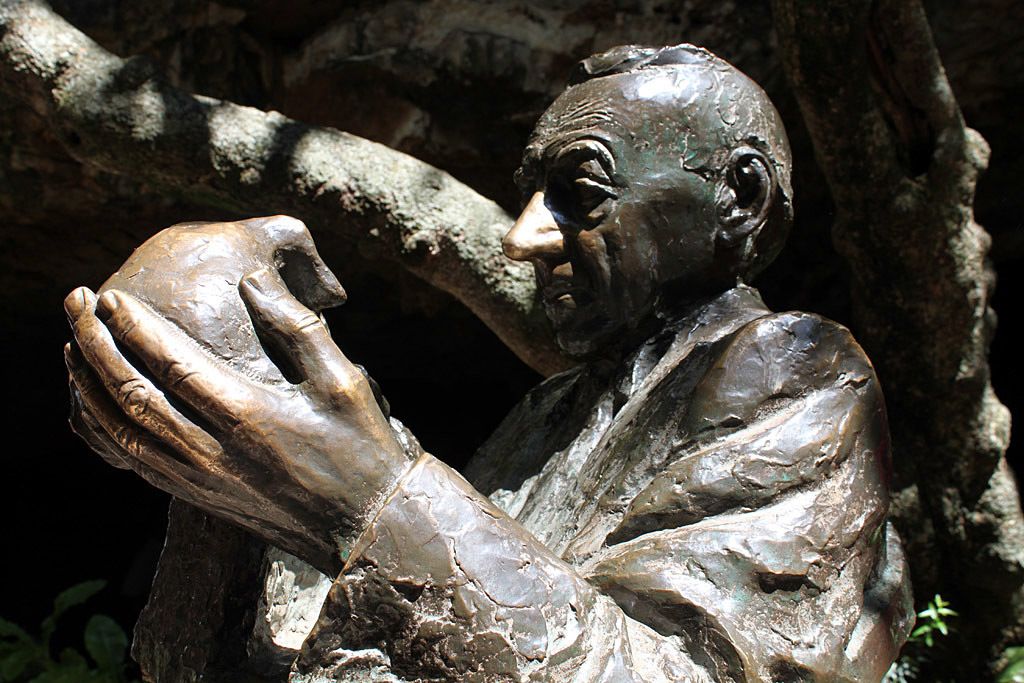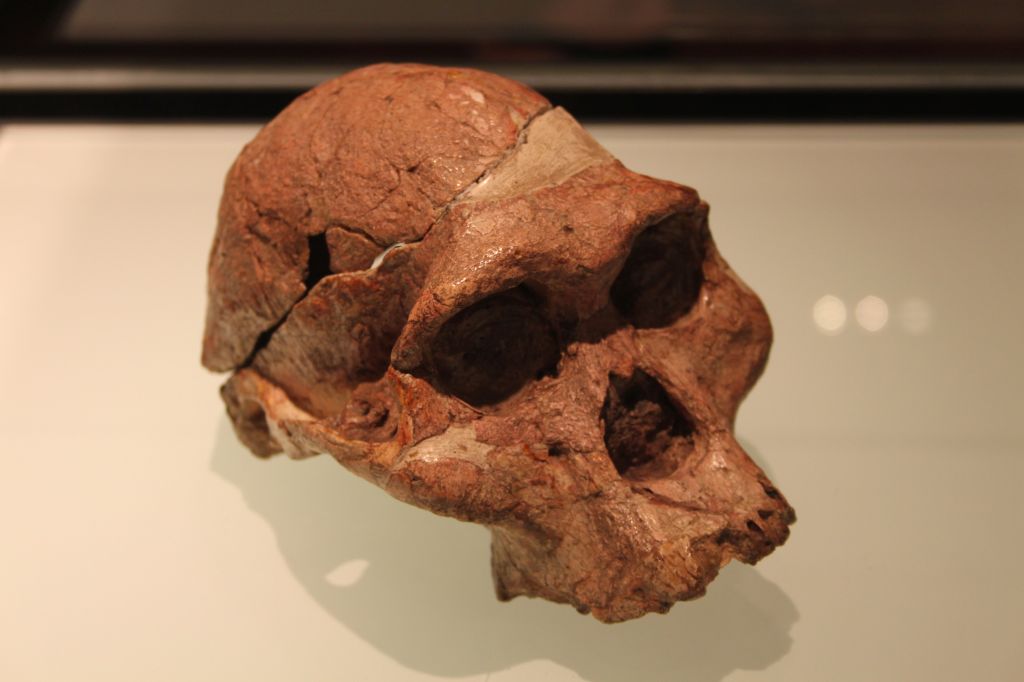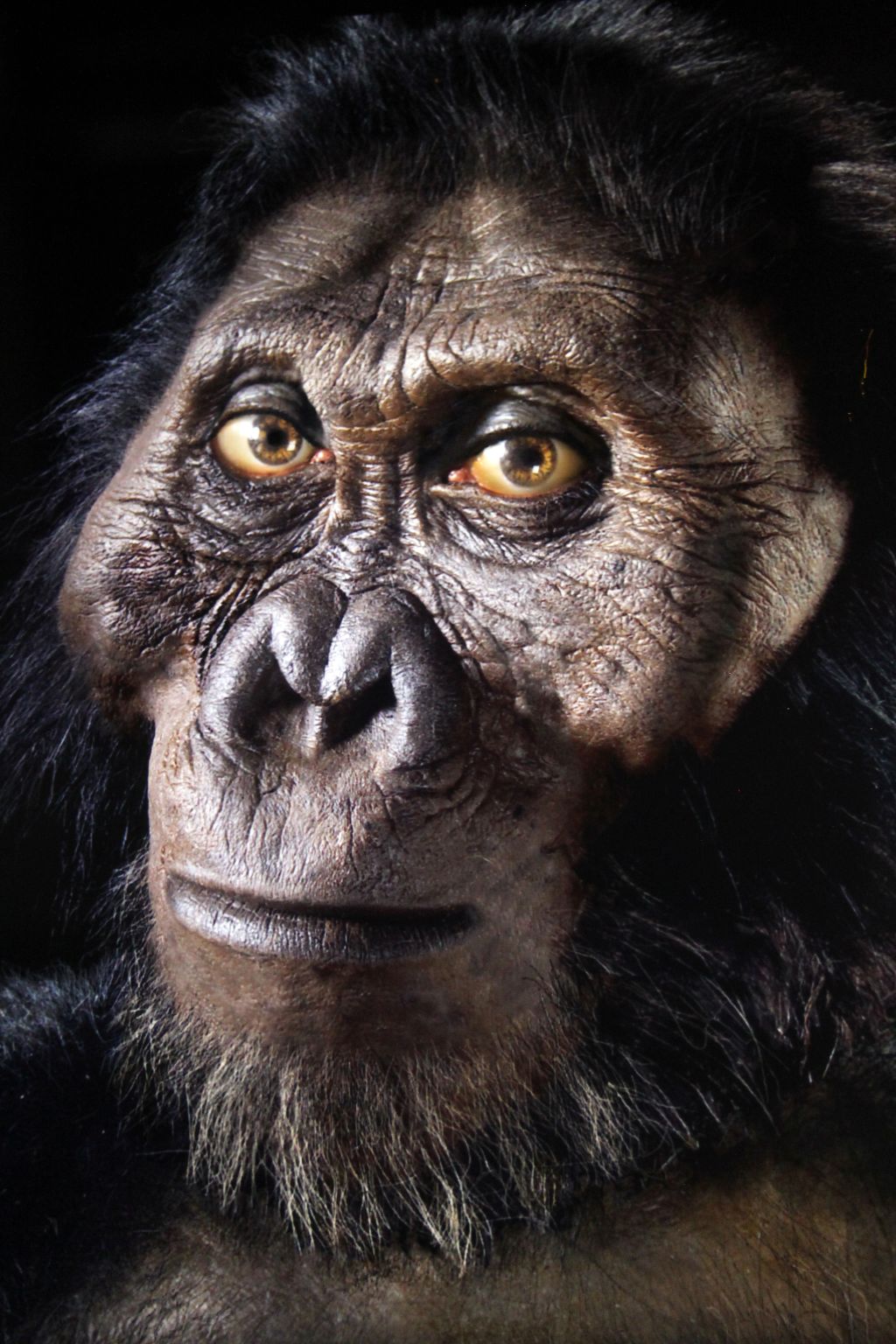The age of Australopithecus
Australopithecus was an early ancestor of modern humans, was much smaller than us, and walked upright, but was probably unable to make tools.
South Africa, and the Cradle of Humankind in particular, is extremely rich in Australopithecus fossils, which are rare in the world as a whole.
Professor Raymond Dart of the University of the Witwatersrand identified the first Australopithecus fossil at Taung, in what is now the North West Province of South Africa, in 1924. He gave the fossil, the Taung Child, the species name Australopithecus africanus, which means “southern ape of Africa”.
But Australopithecus africanus was not an ape at all. It was an upright-walking hominid with human-like teeth and hands and some ape-like features, such as a small brain, flattened nose and forward-projecting jaws.

Many fossils of Australopithecus have since been recovered from Sterkfontein and the Makapans Valley in South Africa, and from sites in East Africa.
The Cradle of Humankind is renowned for its Australopithecus africanus specimens, which lived between 3-million and 2-million years ago. The first adult fossil of this hominid (TM 1511), was found at Sterkfontein by Dr Robert Broom in 1936. A well-known example is “Mrs Ples” (Sts 5), which was discovered by Broom and John Robinson in 1947.
But there are other Australopithecus specimens discovered in the Cradle of Humankind, which are not Australopithecus africanus. These include several specimens, such as Stw 252, excavated by Alun Hughes and Phillip Tobias, and Sts 71, discovered by Broom and John Robinson in 1947.
How would you know an Australopithecus if you bumped into one?
The australopithecines were apelike, but were different from the other great apes of the past and today in that their powerful jaws housed smaller canines – though they were still larger than ours. They were also habitually bipedal, meaning they regularly walked upright (other great apes walk upright only in short stints).
They were shorter and lighter than modern humans, weighing between about 27 kg and 49 kg (60 lbs and 108 lbs), and ranging from about 1.1 m to 1.5 m (3’ 7” to 4’11”) tall – very similar to modern chimpanzees. Their brain capacity was also comparable to that of the modern great apes, at about 390 cc to 550 cc, or about a third of modern humans’. Their jaws projected more than ours.
They had strong, slightly curved, fingers and thumbs, while their feet were short, with less flexible toes than other apes and more like ours. Their strong arms and fingers could have aided climbing, which may mean they spent some of their time in trees.
We know little about their superficial appearance or the colour of their skin, but they probably had a similar amount of body hair to today’s great apes.
Males and females of some Australopithecus species looked very different. Males of some species were much larger than females, as with other primates, such as gorillas and orangutans. This characteristic is called sexual dimorphism.
Between 4-million and 2-million years ago, you might have bumped into an Australopithecus anywhere in East or Southern Africa – they ranged widely over the continent.
How the first Australopithecus was found

In the early part of the 20th century, palaeontologists believed that humankind’s origins lay in Asia or Europe. Professor Raymond Dart’s theory that the Taung Child was a human ancestor was not well received. He did, however, have a supporter in Dr Robert Broom, a keen palaeontologist who had until then had specialised in fossils of mammal-like reptiles found in the Karoo.
After the Taung Child was discovered, Broom, determined to find an adult Australopithecus, went looking in dolomite caves west of Pretoria. He discovered instead the fossil of a giant baboon, which received considerable press coverage.
After reading about the baboon in a newspaper, two students, Harding le Riche and GWH Schepers, who had visited the Sterkfontein Caves and recovered fossil monkeys, approached Broom and encouraged him to visit the caves with them.
At Sterkfontein, Broom met George Barlow, the site manager, who, as luck would have it, had also worked at Taung. Broom asked Barlow to keep a look out for anything similar to the Taung Skull, and a few days later, Barlow handed him a rare find, a natural brain cast in rock of the world’s first adult specimen of Australopithecus, later catalogued as TM 1511.
“No diamond cutter ever worked more lovingly or with such care on a precious jewel – nor, I am sure, with such inadequate tools. But on the seventy-third day, December 23, the rock parted. I could view the face from the front, although the right side was still imbedded … What emerged was a baby’s face, an infant with a full set of milk teeth and its permanent molars just in the process of erupting. I doubt if there was any parent prouder of his offspring than I was of my Taung baby on that Christmas.” – Professor Raymond Dart, on freeing the Taung Child – the world’s first Australopithecus – from the rocky breccia that surrounded it, in 1924
Diverging branches of Australopithecus
Australopithecuswas one of our most ancient hominid ancestors. There were manyAustralopithecusspecies.
Different Australopithecus species lived in Southern and East Africa from about 4-million years ago until about 2-million years ago. Palaeoanthropologists are still trying to understand the relationships between the different species because the fossil record for Australopithecus is fragmented and limited, and new australopithecine finds are constantly coming to light.
Australopithecus anamensis, Kenya
Lived 4.2-million to 3.9-million years ago. Discovered in Kenya in 1994. It probably walked upright and lived in open woodland habitats in what is now Kenya and Ethiopia.
Australopithecus afarensis, Ethiopia and Kenya
Lived 3.6-million to 3-million years ago.Small brained, walked upright, mostly herbivorous. Climbed trees well and lived at a time when Africa was forested. Best example of this species is “Lucy”.
Australopithecus bahrelghazali, Chad
Lived 3-million years ago.The type specimen of this species is a mandible (lower jaw) fragment, found in a dry river bed in 1993 in Chad, the furthest west any Australopithecus has been found.
Kenyanthropus platyops, Kenya
Lived 3.5-million to 3.2-million years ago. Kenyanthropus platyops had primitive features including small ear holes, but a lower face that was similar to the Homo habilis skull KNMER 1470. This cranium is referred to by some as Australopithecus platyops.
Australopithecus africanus, South Africa
Lived 3-million to 2-million years ago.Australopithecus africanuswas similar to Australopithecus afarensis. The best-known examples of this hominid are the Taung Child and “Mrs Ples”.

Australopithecus species (unnamed), South Africa
Lived 3.2-million years ago. An Australopithecus skeleton nicknamed “Little Foot” was found in the Sterkfontein Caves in 1997. Once fully excavated, it will be assigned a species.
Australopithecus garhi, Ethiopia
Lived 2.5-million years ago. Australopithecus garhi may prove to be the link between the Australopithecus and Homo genera, and may have made the first stone tools – though researchers debate both these points.
Our ancient ancestors
“Mrs Ples”
“Mrs Ples” is the most complete skull of an Australopithecus africanus specimen ever discovered. The skull was found encased in breccia (a rocky matrix) at Sterkfontein in 1947, by palaeontologist Dr Robert Broom and his assistant, John Robinson.
The discovery of “Mrs Ples” helped to highlight the view that humankind was born in Africa – a theory that most scientists were sceptical of at the time.
Mrs Ples was so named by The Star newspaper when Broom said it was an elderly female of the species Plesianthropus transvaalensis (“near-human from the Transvaal”), although the skull was later identified as belonging to the same species as the Taung Child, Australopithecus africanus, a distant ancestor of humankind.
Broom suggested that the skull of “Mrs Ples” represented a female, based on the small size of the sockets for the canine teeth.
Dr Francis Thackeray of the Transvaal Museum has argued that “Mrs Ples” is the fossil of a young male, although others, including University of the Witwatersrand Professor Ron Clarke, disagree.
Whatever gender she or he was, the individual was an adolescent. If that individual had in fact been male, he would have been relatively small.
“Mrs Ples” was clearly on the road to humanity. This hominid could walk upright, but had a small brain, similar in size to that of a modern chimpanzee.
At about 2.1-million years old, “Mrs Ples” is one of the youngest known fossils representing Australopithecus africanus. Not long after that, Australopithecus africanus became extinct.

“Lucy”,Australopithecus afarensis
“Lucy” is the partial skeleton of a 3.2-million-year-old Australopithecus afarensis from East Africa. It is arguably the most well-known hominid skeleton in the world.
Dr Donald Johanson and his team discovered the skeleton in Hadar, Ethiopia in 1974.
Formally known as AL288-1, “Lucy” was nicknamed after the popular Beatles’ song Lucy in the Sky with Diamonds, which the excavation team had been listening to on the radio.
Although the skeleton consists of only 47 out of the 206 bones in the human body, it paints a remarkable picture of early hominids in East Africa. Lucy was a mature adult but stood only about 1 m (3’3”) tall.
Lucy had arms that were slightly longer relative to those of humans (her arms and legs would have been similar lengths, while humans’ legs are longer than their arms). These longer arms and curved hand bones lead palaeoanthropologists to believe that Lucy would have been an agile tree climber, although some doubt whether she actually used these traits or if they were just evolutionary features left from earlier hominids. Many others, however, are convinced that she was a tree climber.
“Lucy’s baby”
In 2000, palaeoanthropologist Zeresenay Alemseged found a remarkably preserved baby female fossil that dates to about 3.3-million years ago. The three-year-old Dikika baby, named after the region in which it was found near the winding Awash River in Hadar, Ethiopia, has been dubbed “Lucy’s baby” after the famous 3.2-million year-old adult found in 1974.
But the baby may eventually outshine its mother.
Its nearly complete skull, torso and fragmented arms and legs offer new clues about Australopithecus afarensis. Its partial knee and nearly complete leg and foot are built for bipedalism, yet its shoulders are suited for climbing, reinforcing existing theories that it was part-arboreal.
Australopithecus lived in Eastern and Southern Africa between 4.2-million and 2-million years ago. “Lucy” and “Mrs Ples” are arguably East and South Africa’s most famous Australopithecus fossil finds.
However, they are not the oldest hominid fossils. Hominid fossils dating up to about 7-million years ago have been found in East and North Africa.
Some of the oldest hominids (precursors of Australopithecus)
Sahelanthropus tchadensis
This species is formally known as Sahelanthropus tchadensis, but is nicknamed “Toumai” (“hope of life” in the local Goran language). A skull of this species, dated to approximately 7-million years ago, was discovered in Chad in 2001. The fossil perhaps represents the earliest known ancestor to humans.
Orrorin tugenensis
Orrorin tugenensisis represented by 13 fossils found in the Tugen Hills of Kenya in 2000. The fossils include a partial femur, lower jaw fragments, and several teeth. Dated to about 6-million years ago, this species could represent the proverbial “missing link” between apes and hominids, although its position in the hominid family tree is highly contested at present.
Ardipithecus ramidus kadabba
Ardipithecus ramidus kadabbais an approximately 5.8-million year old species discovered in the Middle Awash River Valley of Ethiopia over a four-year period and announced in 2001. Although the fragmentary remains include a partial lower jaw with teeth, hand and foot bones, pieces of three arm bones and part of a collarbone, it is a single toe bone which is probably the most important find. The shape of this bone suggests this ape-like creature walked on two legs, presumably making it an early hominid very close to the branching point between apes and humans.
Return to the Exhibition Guide.